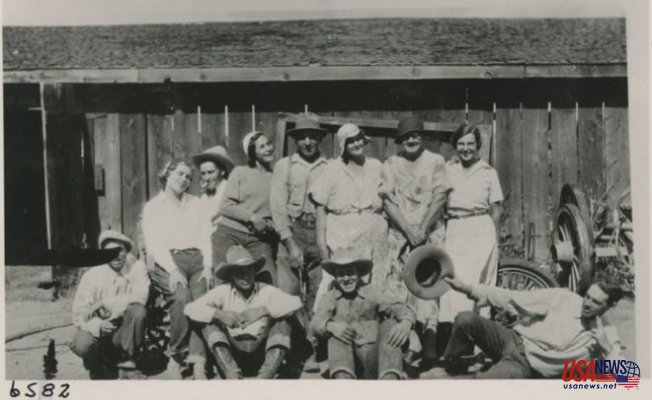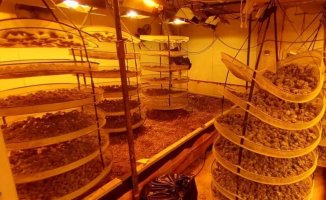For 2 hours that the kids were stranded on a haystack on the household's Nevada ranch, not able to get home since the rabid cow pawed and raged out the home. It was beginning to become chilly, and the kids pleaded with their mom to allow them to sprint for the home because the sun dipped low in the skies.
She shouted at the children by the front porch. "Burrow down beneath the hay to stay warm, but do not dare come home"
Olds awaited her eldest son, optimistic he'd come home shortly from a day of searching, and with sufficient ammunition to take the crazed cow deceased.
'Best calamity' to strike on the country
While many scholars have drawn parallels between the COVID-19 pandemic as well as the nationally Spanish Flu outbreak of 1918, Nevada fought a different virus 100 decades back, one quite different from the book coronavirus.
In various ways, but the battle was exactly the same, marked by people pushback against mitigation measures and the problem of balancing the security of livelihoods together with the struggle against an infectious illness.
From about 1915 to 1920, the country was grappling with an epidemic of rabies that jeopardized not only the health of individuals and animals, but also the nation's culture and market.
It had been believed the"biggest calamity that had occurred in the country," in accordance with the 1984 article"Rabies at Rangeland Environments," printed by the scholarly Rangelands Journal.
Ranchers' livelihoods were especially at stake since their possessions were bait for wild creatures that roamed the desert looking for something, anything to snack.
Much like the immunity seen toward steps to protect against the spread of this novel coronavirus, there were Nevadans then who were loath to modify their practices to protect against the spread of rabies. Ranchers most of feared changes may negatively impact their viability for a ranch. 1 misstep could finish an whole operation.
Animal activists and rich elite equally also balked at top-end dictates, the most contentious one in that time being to quarantine and muzzle most dogs.
In her own house, Olds, the pioneering cattlewoman, bickered with her loved ones about if rabies was really worth fretting about. The bickering ceased when Babe the bunny went crazy.
"She bellowed... the very maniacal bellow I have ever seen.
The family told Olds that it was her imagination.
By day's end, nobody was laughing. As her eldest son returned home in the search, the deranged cow billed . With a single shot into the mind, the bunny was dead.
"If I'd known he had just 1 shell, I believe I'd have dropped," Olds wrote.
It's a gruesome and frequently deadly virus when untreated.
Nowadays, rural inhabitants around the globe are vulnerable. It was not any different in the early 1900s from the Silver State. Homesteaders were settling one of their feral neighbors, which lent the rabies outbreak further capability to devastate the human inhabitants of the West. The virus, which may infect any mammal, frequently contributes to aggressive biting behaviour in the host creature to optimize odds of having a new host, according to the CDC.
Cases were reported as early as 1909 from the Southwest, based on newspaper articles in the moment, but they had been dispersing rapidly by 1915 during California and Nevada.
Scholars indicate the outbreak could have originated using animals like coyotes from the Southwest, which then assaulted and spread the virus into pets and livestock.
Rancher Pete Lorda understands what is at stake and how fast he will need to impress upon his young ranch hands that the significance of taking the issue seriously.
The thing of muzzles
For centuries, dogs are among the largest rabies risks to individuals since they're generally the connection between individuals and the rest of the animal kingdom.
After the epidemic started to take hold, local and state authorities in the western U.S. started turning to muzzles as a preventative step on the advice of medical specialists.
In 1915, instantly after Nevada started visiting rabies instances, W.B Mack, a vet, bacteriologist and manager of state veterinary management service in the University of Nevada at Reno, began publishing dire public service announcements in newspapers across the nation.
"In a neighborhood where rabies is widespread, the actual dog lovers should attempt to safeguard their dogs against disease, and it appears to me a muzzling ordinance... must meet the acceptance of all owners and lovers of all puppies," Mack wrote.
He added that this was imperative in rural regions since rabid creatures, and their path of victims, were far much more likely to go unnoticed.
Dogs in the time served as security for both livestock and humans, as herders and companions within lonesome stretches of large desert.
In a struggle that is reminiscent of the pushback against mask-wearing, many rebelled when specialists concentrated on muzzling their furry friend.
In a year, but the situation had become severe, according to Mack.
"The disease has spread across the northern counties till nearly half the condition is involved. It's by far the most serious outbreak with which Nevada has had to cope, both in its stance on human health and the livestock business," Mack composed in 1916.
That year, the Elko Independent reported that a $100,000 reduction in livestock statewide, which could equate to approximately $2.5 million now.
Plus it started taking a human tollfree. Over 40 people were treated to the disorder, the identical article reported, many in the college in Reno.
The very first human death reported from the nation was a 1-year-old Humboldt County boy who had been drinking milk in the family cow, that died from rabies days ahead of the kid took ill, the Elko Independent reported at February 1916.
Leaders from the West at 1916 coordinated a rabies conference to discuss ideas and policies, and also the Silver Condition ended up making a country rabies commission to dictate decisions made in the home.
Most counties imposed muzzling needs, with a few counties allowing law enforcement to take and kill any puppy seen leash off.
Ranchers also searched for answers into one of the most significant challenges faced by their own herds: shielding their critters from rabid coyotes while transferring them south through winter. Remaining in position meant running from food.
In his novella, Laxalt explained one literary scene of the Type of coyote attack probably experienced by ranchers in the time:
The clearing in which the ring was a scene of absolute chaos and crashing gunfire. The lineup of coyotes had attained the ring and so were darting everywhere, snarling and slashing since they moved. .
Because of this, bounties to get coyote carcasses improved as incentive to kill as many coyotes as you can.
The inhabitants was culled radically from Idaho to California. In Oregon, hunters can snag up to $17.50 per head to get a coyote.
It is tough to discover any conclusive death toll or complete price from the rabies outbreak of the early 1900s at Nevada. Unlike the current coronavirus pandemic, the amount of individuals who perished appears to have stayed relatively low, as a result of muzzling ordinances and Pasteur's immunization therapy.
When some skeptics of this vaccine existed, many were more fearful of this nearly guaranteed departure if a rabies wound has been left untreated.
The price for the nation's agricultural sector, nevertheless, was hundreds if not tens of thousands of creatures and livestock.
In Olds' situation, she ended up dropping five head of cattle through the outbreak, such as a decoration red Durham bull the household had spent a complete year's economies on.
"To mepersonally, the bull represented the forthcoming recognition of my dreams," composed Olds.
Lessons learned
The COVID-19 pandemic was vastly different from the rabies outbreak a century past. To begin with, the best toll was on lives: over 3,300 Nevadans dropped last year.
Few understand the human effect greater than Caleb Cage, '' the nation's COVID-19 response manager.
"In my years of emergency management, and almost two years of direction, this outbreak is undoubtedly the hardest and complicated set of issues I have ever encountered," said Cage.
Cage, such as many Nevadans, hadn't heard of this rabies outbreak that plagued his home nation a century past. However he had been comfortable with the Spanish influenza.
In his occupation as emergency supervisor, he had been tasked with maintaining the country ready for reacting to a similar influenza outbreak. That preparedness comprised routine exercises for dispersing a vaccine into the general public.
The struggle with any outbreak is that there will always be rival interests, Cage said. Preventative measures will frequently upend the lives of individuals, whether it's their degree of relaxation, or their financial safety, or their average freedoms.
"There has not been an easy afternoon, or a simple choice, or a simple policy to urge," said Cage. "All the choices have been challenging. They've come down to some balance. If we proceed far too this manner, we might drop lives, and when we go too far the otherwe also could lose lives for different explanations."
While memories of this century-old rabies outbreak have all faded, many expect lessons learned in the coronavirus pandemic will adhere.
Olds, who proceeded to conduct a prosperous ranch hotel, perhaps said it best.













